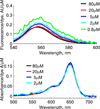Far-red organic fluorophores contain a fluorescent impurity
- PMID: 24782148
- PMCID: PMC4180537
- DOI: 10.1002/cphc.201402002
Far-red organic fluorophores contain a fluorescent impurity
Abstract
Far-red organic fluorophores commonly used in traditional and super-resolution localization microscopy are found to contain a fluorescent impurity with green excitation and near-red emission. This near-red fluorescent impurity can interfere with some multicolor stochastic optical reconstruction microscopy/photoactivated localization microscopy measurements in live cells and produce subtle artifacts in chemically fixed cells. We additionally describe alternatives to avoid artifacts in super-resolution localization microscopy.
Keywords: fluorescence; fluorescent probes; live cells; quantitative imaging; super-resolution imaging.
© 2014 WILEY-VCH Verlag GmbH & Co. KGaA, Weinheim.
Figures





Similar articles
-
Photoblueing of organic dyes can cause artifacts in super-resolution microscopy.Nat Methods. 2021 Mar;18(3):253-257. doi: 10.1038/s41592-021-01061-2. Epub 2021 Feb 25. Nat Methods. 2021. PMID: 33633409 Free PMC article.
-
A detailed review of genetically encodable RFPs and far-RFPs and their applications in advanced super-resolution imaging techniques.Biophys Chem. 2025 Jul;322:107432. doi: 10.1016/j.bpc.2025.107432. Epub 2025 Mar 15. Biophys Chem. 2025. PMID: 40117991 Review.
-
Direct stochastic optical reconstruction microscopy (dSTORM).Methods Mol Biol. 2015;1251:263-76. doi: 10.1007/978-1-4939-2080-8_14. Methods Mol Biol. 2015. PMID: 25391804
-
Fluorescent probes for super-resolution imaging in living cells.Nat Rev Mol Cell Biol. 2008 Dec;9(12):929-43. doi: 10.1038/nrm2531. Epub 2008 Nov 12. Nat Rev Mol Cell Biol. 2008. PMID: 19002208 Review.
-
Multicolor super-resolution fluorescence imaging via multi-parameter fluorophore detection.Chemphyschem. 2012 Jan 16;13(1):99-107. doi: 10.1002/cphc.201100735. Epub 2011 Dec 23. Chemphyschem. 2012. PMID: 22213647 Free PMC article.
Cited by
-
Photoblueing of organic dyes can cause artifacts in super-resolution microscopy.Nat Methods. 2021 Mar;18(3):253-257. doi: 10.1038/s41592-021-01061-2. Epub 2021 Feb 25. Nat Methods. 2021. PMID: 33633409 Free PMC article.
-
Method to identify and minimize artifacts induced by fluorescent impurities in single-molecule localization microscopy.J Biomed Opt. 2018 Oct;23(10):1-14. doi: 10.1117/1.JBO.23.10.106501. J Biomed Opt. 2018. PMID: 30334394 Free PMC article.
-
Synergistic factors control kinase-phosphatase organization in B-cells engaged with supported bilayers.Mol Biol Cell. 2020 Mar 19;31(7):667-682. doi: 10.1091/mbc.E19-09-0507. Epub 2019 Dec 26. Mol Biol Cell. 2020. PMID: 31877064 Free PMC article.
-
Defining the Basis of Cyanine Phototruncation Enables a New Approach to Single-Molecule Localization Microscopy.ACS Cent Sci. 2021 Jul 28;7(7):1144-1155. doi: 10.1021/acscentsci.1c00483. Epub 2021 Jun 3. ACS Cent Sci. 2021. PMID: 34345667 Free PMC article.
-
Blue-conversion of organic dyes produces artifacts in multicolor fluorescence imaging.Chem Sci. 2021 May 18;12(25):8660-8667. doi: 10.1039/d1sc00612f. eCollection 2021 Jul 1. Chem Sci. 2021. PMID: 34257864 Free PMC article.
References
-
- Heilemann M, Margeat E, Kasper R, Sauer M, Tinnefeld P. J. Am. Chem. Soc. 2005;127:3801–3806. - PubMed
-
- Bock H, Geisler C, Wurm CA, von Middendorff C, Jakobs S, Schönle A, Egner A, Hell SW, Eggeling C. Appl. Phys. B. 2007;88:161–165.
Publication types
MeSH terms
Substances
Grants and funding
LinkOut - more resources
Full Text Sources
Other Literature Sources

